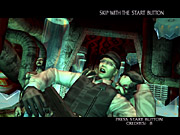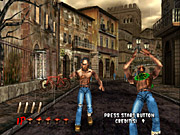Probably one of the most significant changes in video games over the past 10 years has been the shift in focus from arcades to home console systems. While the arcade-style light-gun game enjoyed a slight revival in the mid-'90s, the genre has slowly but surely run out of steam as its primary venue, the arcade, has vanished. Released in 1998, Sega's The House of the Dead 2 was arguably one of the high points of the genre, with a consistent level of challenge, sharp graphics for its time, and, of course, terrible but endearing voice acting. Now, Sega and Wow Entertainment are wheeling out the House of the Dead franchise for a third time, this time exclusively on the Xbox. The basic form and function of a light-gun game are here, but whether or not that's going to capture anyone's attention at this point is highly questionable.

The House of the Dead III picks up 19 years after the events in The House of the Dead 2. The story revolves around Lisa Rogan and G, one of the characters from The House of the Dead 2, and their attempt to rescue Lisa's father from the bowels of an abandoned and creepy industrial complex. Unfortunately for them, it seems this facility houses some of the especially nasty experiments of Dr. Curien, the scientist who has single-handedly provided the light-gun fodder of all three House of the Dead games with his insane experiments with the undead. Though you'll put down wave after wave of zombies, interspersed with the occasional boss battle, the game lacks a singular head villain for you to chase after, such as the evil Goldman from The House of the Dead 2.
Light-gun games have remained essentially the same for the past six years, and, for the most part, The House of the Dead III honors this tradition, automatically moving the camera "on rails" from location to location so that zombies can pop up and be subsequently turned into green goo. As you make your way through the game, you'll occasionally be faced with what appear to be different paths, though multiple plays through the game reveal that you'll go through the same levels each time, and the path choices simply dictate your route.
The only real deviation the game makes from the series' tried-and-true formula is its the inclusion of an auto-reload feature, which eliminates the need to shoot the light gun offscreen to reload it. This isn't an inherently bad idea, but in practice it takes far too long to reload, slowing down the pacing of the game considerably and subsequently undermining much of the game's sense of urgency. More importantly, as was the case with the US Dreamcast, the Xbox has no official first-party light-gun controller, and Sega has not taken the initiative to manufacture its own. Instead, players will have to either use a standard Xbox controller, which works surprisingly well, or a third-party light-gun controller. Currently, Mad Catz produces the only light gun available for the Xbox. In the right setup, this gun is actually very effective, but it's hard to calibrate and becomes wildly inaccurate if the tip of the barrel is more than three feet away from the screen. The lack of a really good light gun peripheral for the Xbox, such as Namco's exceptional GunCon controller, is unfortunate, and it makes it just that much harder to enjoy The House of the Dead III. Though the stock Xbox controller might get the job done, playing a light-gun game without a light gun just isn't nearly as satisfying.
Once you've completed The House of the Dead III, which can be breezed through by competent players in under an hour, an almost pitch-perfect port of The House of the Dead 2 is unlocked. It's interesting to play The House of the Dead 2 right after finishing its successor, as it really exposes how sluggish the auto-reload feature is and how much easier The House of the Dead III is. You'll also find a "making of" featurette for the upcoming The House of the Dead feature film, which looks so amazingly bad that it might actually be funnier than the voice acting in The House of the Dead 2.
The House of the Dead movie might give The House of the Dead 2 a run for its money in terms of bad comedy, but the contest for most-hysterical sound design between The House of the Dead 2 and The House of the Dead III easily goes to the former. The voice acting in The House of the Dead III is technically more consistent, but it lacks the charm of The House of the Dead 2. And while there's no shortage of bad dialogue and stilted delivery, it's rarely so bad that it's funny--instead, it's just boring. The rest of the game's sound design follows suit, with generic shotgun sounds and a pastiche of zombie moans and groans.
The game's visual presentation definitely fares better, and it's easily the most well-produced aspect of The House of the Dead III. Early on in the game's development, Sega revealed that The House of the Dead III would be rendered using the cel-shading technique, but this plan was apparently nixed between then and now, as the final version of the game only shows minimal traces of this cartoon-inspired technique. Without this sharp divergence in style, the game evokes the same dark, grimy look of its predecessors, and most of the zombies look like upgraded versions of the zombies you've probably seen in previous House of the Dead games.

On the other hand, the bosses you'll encounter have gone from inventive and macabre to absolutely absurd. Excellent examples of this include the enormous, club-swinging security guard abomination in the first level, or the gigantic zombified sloth you encounter shortly thereafter. And we won't ruin the surprise for you, but the final boss in the game is downright laughable. Still, design choices aside, the game's graphics are technically sound, sporting detailed textures, crisp character models, and a fair amount of atmospheric lighting. One of the most effective uses of lighting plunges you into complete darkness, giving you only a flashlight to guide your way through the level.
It could be argued that being able to disable the otherwise unavoidable auto-reload feature in The House of the Dead III would have made it a significantly more challenging endeavor, and this might be true. But honestly, the mere fact that this is a light-gun game is going to dissuade more people from playing it than any specific mechanics it might have. With no similar competition on the Xbox, The House of the Dead III should satiate players looking for a light-gun fix, especially considering the inclusion of The House of the Dead 2 as a bonus. It could even serve as a passable introduction to the genre for players who haven't touched a light gun before. But if you're already worn out on the gameplay of other rail-based light-gun games, you'll find little to draw you back in House of the Dead III.